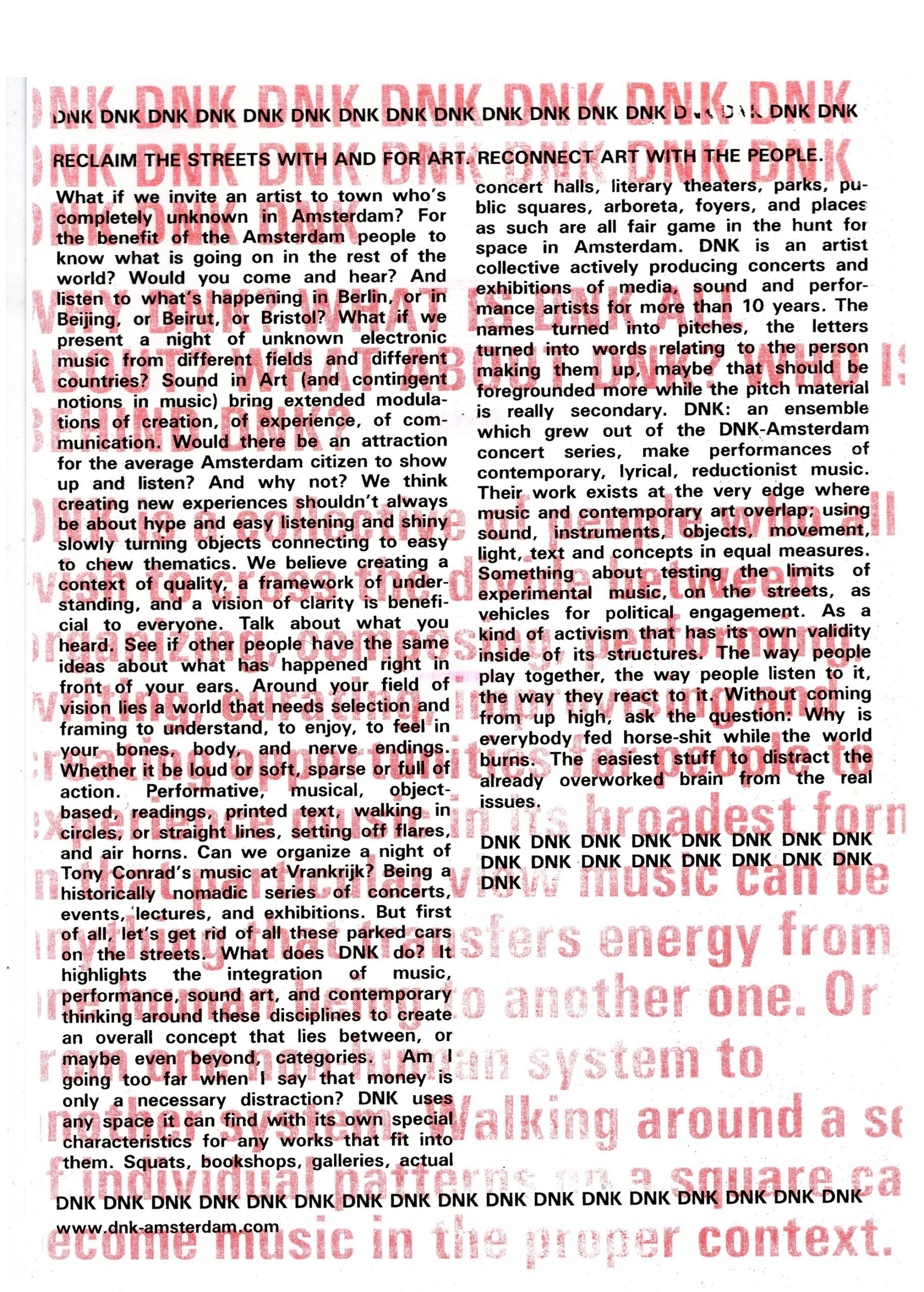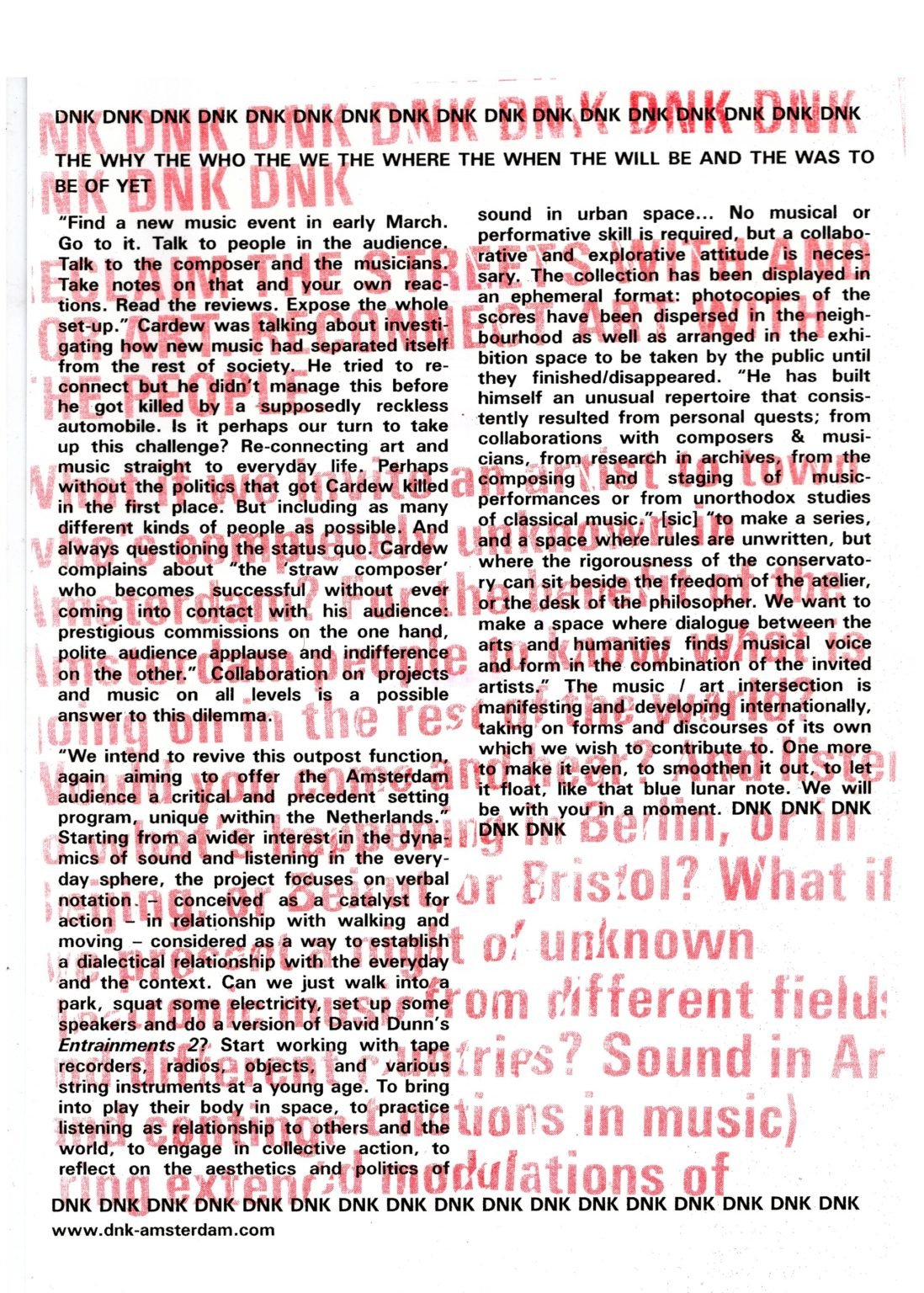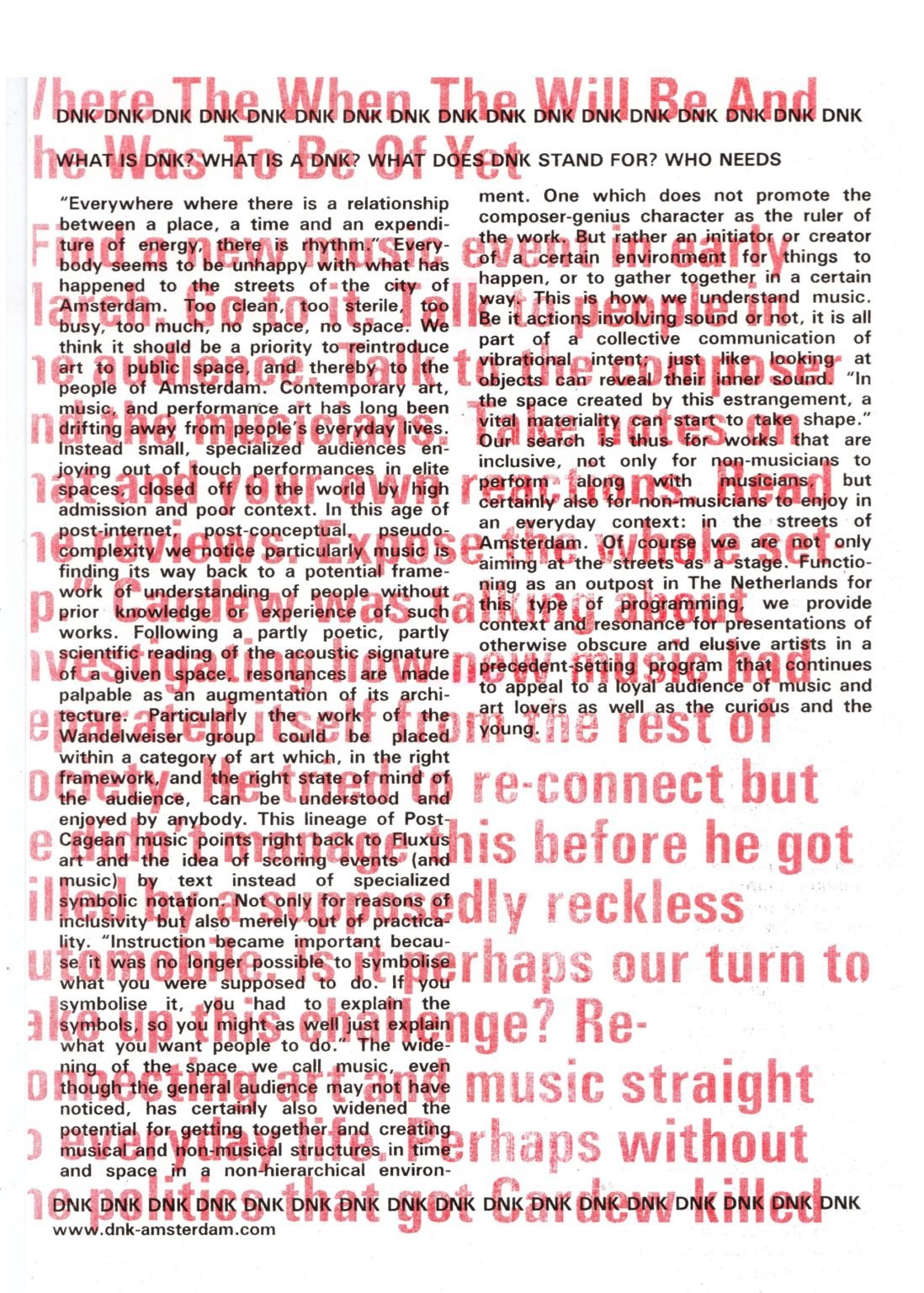In Conversation with DNK Amsterdam: The experimental art and music performance collective discusses improvisation, situations and audience
On the occasion of the launch of our latest issue on sound, DNK Amsterdam – a constellation of artists and musicians that interrogates the intersection of sound, performance, music and the public sphere- produced a studio recreation of their original performance ‘Manifesto’ which took place at artist space W139 on 12th of January 2020.
Nicholas Burman went to talk with DNK Amsterdam: a conversation on how the experimental art and music performance collective thinks about improvisation, situations and audience
DNK has been active in Amsterdam since 2005, when they began by hosting a series of experimental musical performances at the OT301 and later at the now defunct SMART Project Space. They have since curated a range of shows under the DNK Days umbrella at venues across the city, including collaborative project space puntWG and research/presentation platform De Appel. A recent spoken word performance outlined what the group believes is the issue of ‘specialised audiences enjoying out of touch performances in elite spaces, closed off to the world by high admission and poor context.’ Their work is certainly a good counterpoint to that phenomenon.
Recent events include a performance of Michael Parson’s text based composition Walk (1969) in a public context. For this performance, musicians played the piece while perambulating around Amsterdam’s Dam Square. In 2019, the DNK Ensemble collaborated with Tao G. Vrhovec Sambolec and the inhabitants of Amsterdam’s Woon en Werk Vereniging WG-terrein for Tuning In – the neighbourhood. This performance encouraged residents of the Pesthuislaan to ‘tune in’ with musicians and each other, and collectively play a single note drone for the period of an hour. A personal favourite DNK Days installation of mine was Yutaka Makino’s Displacement, curated as part of the 2018 events series. Makino submerged puntWG in darkness and disorientated visitors. This was thanks to an auditory stimulation that masked the acoustic features of the space and an optokinetic stimulator that destabilised one’s perception of their environment.
It is safe to say that DNK Amsterdam, the Ensemble, and its associated events are interested in exploring what sonic theorist Steve Goodman describes as sound systems, which consist ‘of bodies, technologies, and acoustic vibrations, all in rhythmic sympathy.’ (1) DNK Amsterdam is much more like a constellation than other arts collectives precisely because of their interconnectedness to the audience and the borderlessness of their sound system; the audience’s effect upon the players is an active ingredient in their work. The role of public participation calls to mind Christopher Small’s decision to turn music into a verb, explaining that ‘to music is to take part, in any capacity, in a musical performance.’ (2) Often, at a DNK Ensemble event the constellation of performers and audience members are indeed musicking, as Small would describe it.
In the discussion that follows, artistic directors Koen Nutters, Seamus Cater and Martijn Tellinga from the programming committee discuss the role of improvisation, situations and audience in their work.
How would you describe what it is that DNK Amsterdam, encompassing both the Ensemble and the DNK Days concert series, produces? What do you consider to be your main materials and tools?
Seamus Cater [SC]: DNK Amsterdam produces music and sound related events in the form of concerts, performances and installations. These happen in many different situations that could include concert halls, open fields, art galleries, public spaces and (ex-)squat spaces. Because of the preciousness of space in Amsterdam, an important tool of ours is an ability to sense where a performance could reach its greatest potential, and find a way to make it happen in a fitting context.
Koen Nutters [KN]: A network of possibility floats above everything we do, underneath lays a framework of understanding.
Martijn Tellinga [MT]: Our programme renders a continuous and versatile reflection on issues its members are interested in. Who its members are is in transformation as well, actually, so no aspect of the organisation is a given. We generally curate programmes around rather ambitious questions regarding the materiality and space of music. We want to challenge, confuse or suggest (hypothetical) realities in response to such themes. Our focus and output has steadily been changing over the years, and the tools and platforms we use depend on the specifics of an individual project.
How do you think about improvisation, situation and audience reaction or participation before each performance or installation? Are there specific things you’re trying to achieve within each context, or are the performances organised in order to produce surprises?
SC: Things are always organised with the hope that we will be surprised by the interactions and reactions between performer and audience. We offer a space for composers to play new music, often with our assistance and collaboration. Creating an almost sacred space for quiet music in a place like San Serriffe, which is located in an extremely noisy alley in the red light district, at first seems a difficult prospect, but the closeness of the situation somehow diminishes the everyday interruptions of the outside world. It is as if both the audience and performer have suspended the interference of a constant, brash noise and can concentrate on a musical exchange.
KN: We try to produce a space for listening, experiencing, hearing, seeing, and thinking about contemporary music in a context that anyone who exercises a bit of patience and openness can understand. Maybe not everyone will get it at first, but with a little help, some explanation, some conversation, anyone should be able to get something worthwhile from the experience.
MT: Matters of participation, agency and site specifics have become self-evident to us. Why conceive or produce work that does not somehow test these matters? In some way, indeterminacy has been a red thread throughout most DNK activities, and ‘surprise’ has always been lurking close by. However, I think we are not so much interested in the surprise of indeterminacy, but more so in the space where people (be they performers, audience members or ourselves) are kept on their toes and get a heightened awareness of their situation. In indeterminate circumstances there is always a moment when you leave behind the attempted composition of the unknown and actually wander into the unknown. In a way, that’s where the piece begins, that’s where ideas are tested. And it is something substantially different than improvisation.
DNK Amsterdam is a collaborative affair. How has the constellation of artists evolved over time, and what are the parameters for the collaborations and performers who are involved?
SC: We began as a reasonably typical concert organiser for improvised music, combining electronic and acoustic instruments. The concept expanded to include many more possibilities for ambitious situations. When the DNK Days series moved to a larger art space, it became easier to include installed music and sculptural sound works, and have events happening in different spaces during one evening or day of programming.
KN: Collaboration and collectivity have always been at the core of our beliefs about art. We do not subscribe to the composer-genius character, nor to over-hierarchical situations of scoring for or working with people. Of course there is nothing wrong with organising a number of people to coordinate themselves around certain parameters and/or spatio-temporal situations. But there should always be room for the ensemble to breathe and to put something of their own into the equation.
MT: DNK Amsterdam is in a really interesting phase right now. A relatively large amount of new programmers have joined or old programmers have rejuvenated themselves. For some time already, Koen, Seamus and myself have felt that it would be great if DNK would somehow embrace new activities, touching upon a wider scope of content yet keeping close to our philosophical pursuit of music and sound practices. Are are subjecting DNK’s departure points to new programmer eyes and ears, and to the network they bring. The changes this is bound to cause are only just starting, and any results will be shaped by different types of collaborations and dialogues.
Could you briefly introduce the core DNK Amsterdam team?
KN: Our non-hierarchical structure of people is, as of recently, made up of: Albert Manders, André, Avelãs, Hannah Cheney, Koen Nutters, Lilli Elias, Leroy Chaar, Martijn Tellinga, Mint Park, Seamus Cater, and Tao Vrhovec Sambolec. You will see them appear in and around our events as musicians, organisers, composers, DJs, curators, bartenders, ticket sellers, performers, technicians, programmers, roadies, stagehands, accountants, copywriters, soloists, or whichever other function is required.
Your performances seem very interested in using music to create space for thought, contradictorily using sound to decrease the noise of daily life. Whose practices and thought do you draw on to develop these projects?
SC: There is already so much music that performs almost exclusively as entertainment. We are not trying to add to this. Opening up space for thought is exactly what we are interested in. A lack of sound opens a space for other ideas that hopefully open up the discourse of music, of what it can be. For instance, does music always have to be dependent on sound? Can musical dialogues also exist outside sounding phenomena?
KN: Cage and Deleuze, for instance. If I may quote Joe Panzner, The Process That is the World:
‘Art does not exist to embody an eternal standard of beauty or rational organization, nor does it exist as a tool for communication. Artworks are instead occasions to develop new techniques ofbeing, new styles of seeing and acting within a busy and complex world.’ (3)
MT: Why has DNK Amsterdam historically appealed to an audience that was not exclusively music orientated (but included a lot of art students, art practitioners, etcetera)? This could have to do with the fact that we have always understood music to be a vehicle with which to probe issues beyond the conventional scope of musical practice. Sound, listening and acoustics are very often the main protagonists, but notions of extended practice, (post)conceptual music and extra-musicality have always found their way into our programme. Actually, they are only becoming stronger, with the development of current ideas like “The Expanded Field of Music,” “Critical Music” and “Non Cochlear” sound art. Some of the more obvious contemporary names theorising on this are Douglas Barrett and Seth Kim-Cohen.
You regularly intervene in public spaces with drones and ambience. What do you think about your role as a ‘public’ artistic project? Why is being part of the public, interrupting public spaces, a key theme?
SC: When you play concert music that is not intended as entertainment for the passerby, you open a space for reflection on public space. Should we directly play to those that witness the performance? Should the audience stop and listen? May they join in? Playing in non-conventional spaces potentially disrupts our normalised patterns of behaviour as citizens, at least this is our hope. In this space we can each experience time and our environment differently, resetting the humdrum experience of rushing from A to B without thought.
KN: It’s not a question of interrupting the public space. It’s more about re-introducing the notion of music and performance into the daily life of the people of Amsterdam. We do not go out to disrupt. Our performances are always in collaboration with neighbours and/or neighbourhoods. Or, nearly invisible, for people who are unaware something is happening. Like our recent Dam square performances of Michael Parsons’ Walk piece, which is quite subtle (and very extra-musical). But for the observant eye/ear there is always something slightly out of the ordinary to catch. And for people willing to invest a little time and effort there is a lot to be experienced. They could even join in and perform with us if they like. Not out of the blue, but by showing up early and coordinating with us. This is also part of our agenda: we invite all kinds of people into the ensemble. We did a performance of Cornelius Cardew’s Great Learning with many of W139’s volunteers [an art/gallery space in central Amsterdam], and a piece by André Avelas and myself for 32 people playing simple noise-making devices. Both processes were very inclusive, great fun, and created beautiful performances.
MT: If one sees music in the extended sense, like DNK Amsterdam has been advocating, understanding it as a critical discipline that belongs to contemporary art, it would be strange not to situate it in the public sphere and make it interact with whatever type of dynamic, matter, or information is out there. Music cannot and should not just deal with what has been accepted as musical material, it would stop being relevant if it did this. Curation of the DNK series is also a way to place ourselves in the world, relate to it, respond and communicate to it – much like an artistic practice does.
Has anything surprising ever occurred between you and a member of the public during one of your performances?
SC: During a recent event with the community of and within the WG Terrein in Amsterdam, we were sent a photograph of someone playing a trumpet, looking towards our performance from a different residential block. This seemed like an awakening of the desire for a member of the public to perform music in a community event, despite being separated by a distance of around hundred metres. It was somewhat beyond our expectation, which was that we would end up performing only with people who lived on the specific street we were on. The photo informed us that we affected the wider neighbourhood. It was a way for us to expand community, in a way.
KN: I certainly hope so! Otherwise it has all been for nothing.
MT: I wholeheartedly subscribe to Koen’s answer. Besides silly incidents like people giving input to microphones a bit too enthusiastically, I want to believe (and actually do) that over the years our programme has evoked new experiences and expectations with our audiences. This has to do with surprising people one way or another, and opening up the idea of music that people have. This is, ultimately, what DNK Amsterdam is about.
Credits
DNK ‘Manifesto’
A four part text and performance piece
Compiled, composed, and written by Koen Nutters
Graphic design by André Avelãs
This is a remotely and separately recorded re-creation of the original performance which took place at artist space W139 on January 12, 2020. Edited and mixed by Martijn Tellinga and Koen Nutters in intercontinental quarantine, April 2020
Voices: Koen Nutters, Hannah Cheney, Martijn Tellinga, Lilli Elias
Sine tone players: Mint Park, Martijn Tellinga, Koen Nutters
As part of this performance a recording of the piece ‘Tuning in – the Neighborhood’ by Tao G. Vrhovec Sambolec, performed on May 24th, 2019 by the DNK Ensemble and guests, can be heard.
In Conversation with DNK Amsterdam: The experimental art and music performance collective discusses improvisation, situations and audience - Nicholas Burman
1 mei 2020



